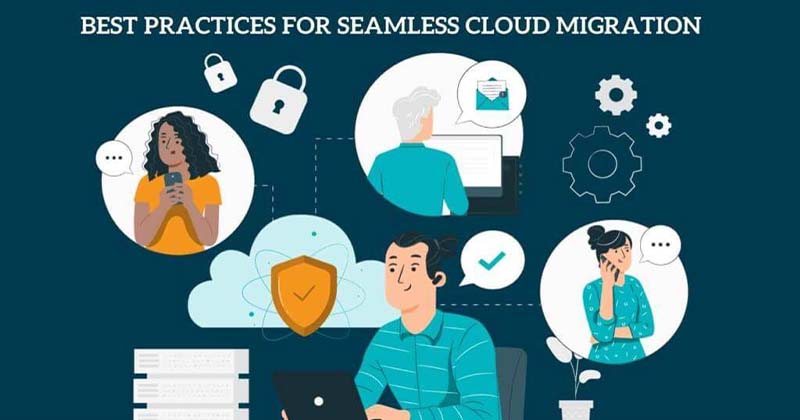In today’s business world, many companies are discovering how helpful it can be to use something called “cloud computing.” Cloud migration is the process of transitioning applications, data, and IT infrastructure to cloud environments. It has become a strategic imperative for companies seeking agility, scalability, and cost-effectiveness.
But moving to the cloud isn’t easy. It’s like going on a big journey, and you need a plan to make sure everything goes well. We’re going to cover all the important aspects. These are essential for ensuring your journey to the cloud is smooth and successful. We’ll cover technical stuff, money matters, rules to follow, and even how everyone in the company feels about it. Let’s explore it all together!
Thorough Assessment and Planning
The initial phase of a cloud migration journey involves a careful assessment. This assessment focuses on understanding the existing IT landscape. Organizations must conduct a comprehensive inventory of applications, data, and dependencies. This includes understanding performance requirements, security considerations, and regulatory constraints. A detailed roadmap is essential for a smooth transition. This roadmap outlines timelines, milestones, and potential challenges. Organizations can gain a better understanding of their IT system by conducting a thorough assessment. This helps them make informed decisions during the planning phase.
Choose the Right Cloud Model
Choosing the right model is a crucial decision. It directly affects the success of migration. Public clouds offer scalability and cost-effectiveness. Private clouds provide enhanced control and security. Hybrid clouds combine the advantages of both. Multi-cloud strategies involve using services from multiple cloud providers. Organizations must carefully evaluate their business requirements. They also need to assess data sensitivity and regulatory obligations. This evaluation is crucial to choosing the most suitable model. This decision sets the stage for a successful migration that aligns with the organization’s strategic goals.
Data Migration Strategies
Data is the backbone of any organization, and its migration to the cloud requires meticulous planning. Organizations should prioritize critical data. They need to assess data volumes and ensure data integrity during the transfer. Encryption, backup procedures, and compliance with data protection regulations are paramount. Pre-migration testing in a controlled environment helps identify and address potential issues. A good plan for moving data to the cloud ensures the organization’s most important asset is transferred smoothly.
Security First
Security concerns consistently rank among the top challenges in cloud migration. Organizations must implement robust security measures. These include encryption, identity and access management, and regular security audits. While cloud service providers offer a secure infrastructure, organizations bear the responsibility. This responsibility involves configuring and managing security settings. Continuous monitoring and proactive threat detection are crucial. They help identify and mitigate security risks in real-time. A comprehensive security strategy is essential. It helps maintain the trust of stakeholders. This ensures the confidentiality, integrity, and availability of data.
Performance Testing
Performance testing is a critical step. It ensures that applications operate optimally in the cloud environment. Simulating real-world conditions helps identify potential bottlenecks and weaknesses. Testing before migration and after migration provides insights into scalability requirements. This enables organizations to optimize their applications for the cloud. Continuous monitoring post-migration ensures that performance remains within acceptable parameters. This iterative approach to performance testing is key. It ensures a seamless user experience and helps achieve the desired benefits of cloud migration.
Cost Management
While the cloud provides scalability and cost-effectiveness, managing costs is crucial. This helps prevent budget overruns. Organizations should implement robust cost management strategies. These actions may include tagging resources for tracking. They may also involve leveraging reserved instances and using auto-scaling efficiently. Regular reviews of resource allocations contribute to a cost-effective and efficient environment. These reviews are based on usage patterns. Cost optimization is an ongoing process. It requires proactive monitoring and adjustments to align with organizational goals.
Disaster Recovery and Business Continuity
Despite the resilience of cloud environments, unexpected events can occur. Robust disaster recovery (DR) and business continuity (BC) strategies are essential. They are imperative to mitigate risks. Regularly backing up data, testing recovery procedures, and establishing recovery time objectives (RTO) and recovery point objectives (RPO) are essential components of a comprehensive DR and BC plan. Cloud providers offer disaster recovery (DR) and business continuity (BC) services. Organizations should utilize these tools to enhance resilience and protect against data loss.
Vendor Lock-In Mitigation
The choice of a cloud provider is a strategic decision that can have long-term implications. Mitigating vendor lock-in risks is crucial. It preserves flexibility and prevents dependency on a single provider. Adopting industry standards is one key aspect. Utilizing cloud-native technologies is another. Embracing a multi-cloud or hybrid cloud strategy is also crucial. Collectively, these actions help organizations avoid vendor lock-in. This approach ensures that applications and data can be easily moved across different cloud platforms. It allows organizations to choose the best services for their specific needs.
Employee Training and Change Management
Cloud migration is not only a technical shift but also a cultural transformation. Providing comprehensive training programs ensures that the workforce is equipped. This allows them to navigate the cloud environment. Implementing change management strategies is important. These strategies address resistance or challenges. They may arise during the migration process. Clear communication contributes to a smoother adoption of cloud technologies. Involving employees in the transition is also essential. Encouraging a culture centered around the cloud empowers the workforce. It enables them to embrace innovation and fully leverage the potential of cloud computing.
Conclusion
In today’s digital era, it’s crucial for organizations to master the skill of moving to the cloud seamlessly. This involves adopting a comprehensive approach. This approach covers technical, financial, regulatory, and cultural aspects. By following best practices, businesses can navigate the process successfully. This involves starting with the initial assessment. It then moves on to continuous improvement. If you don’t want to be involved in this technical or hassled work, entrust your cloud migration to experts like Exhortek Microsoft Consulting. Their knowledge ensures a smooth transition. Leveraging expert knowledge is crucial. They unlock the full advantages of cloud computing. This ensures sustained success in today’s competitive landscape.



